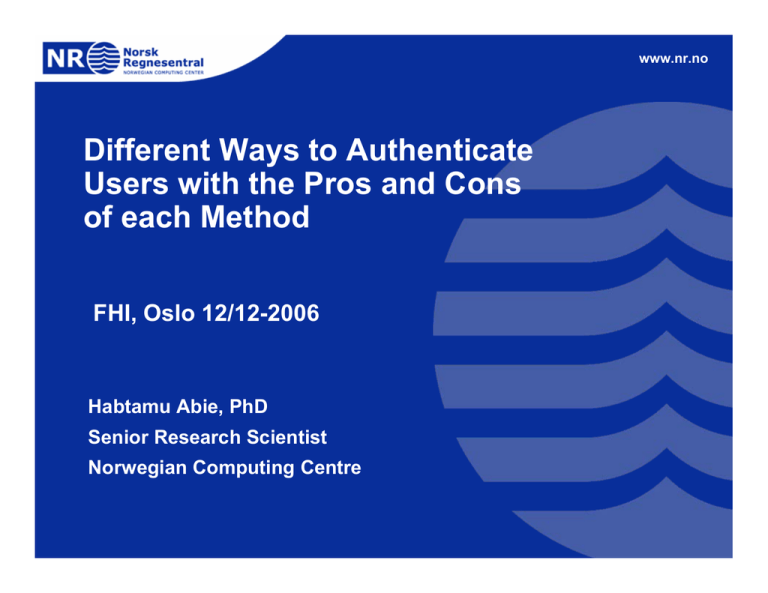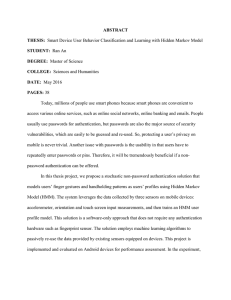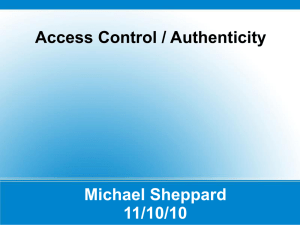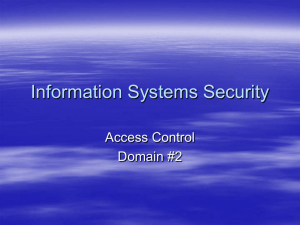Different Ways to Authenticate Users with the Pros and Cons
advertisement

www.nr.no Different Ways to Authenticate Users with the Pros and Cons of each Method FHI, Oslo 12/12-2006 Habtamu Abie, PhD Senior Research Scientist Norwegian Computing Centre Outline ► Authentication: setting the scene ► Different ways to authenticate users ▪ pros and cons of each method ► Technologies for user authentication ► Future trends ► Concluding remarks ► References www.nr.no Authentication: setting the scene ► The authentication problem is simple to describe but hard to solve ▪ two parties are communicating, and one or both wish to establish their identity to the other ► Authentication is the process of verifying ▪ ▪ ► Authentication, the gatekeeper for other security tasks ▪ ▪ ▪ ▪ ► the digital identity of a process/computer the physical identity of a person, i.e. user authentication confidentiality – restricting data access to authorized persons integrity – ensuring data modification by authorized persons non-repudiation – conclusively tracing an action to an individual availability – ensuring availability of data to authorised persons User authentication is a central component of any security infrastructure www.nr.no Authentication: setting the scene… User Client Alice ? Client X Secret A Server Secure Channel Internet Secret X User Authentication ► Host Y Database Secret Y Documents Machine Authentication Alice performs user authentication to client A ▪ ► Resources by demonstrating knowledge of secret A (memorized password) Two machines Client X and Host Y perform machine authentication ▪ by mutually demonstrating knowledge of their respective stored secrets (secret X and secret Y, respectively) www.nr.no Different ways to authenticate users ► Users can be authenticated in many different ways, by using ▪ Something a user knows – e.g. password ▪ Something a user has – e.g. smart-card/token ▪ Something a user is – e.g. biometrics ▪ ► Combinations of the above (aka multifactor authentication) – e.g. PIN-enabled bank card Other methods ▪ Information about a user – attribute authentication ▪ Where a user is – location-based authentication (a special case of attribute authentication) www.nr.no Passwords ► Passwords are simply ‘secrets’ that are provided by the user upon request ▪ ► PINs - specific subset of passwords (comprised of numeric characters only) Using ‘something that is known’ to authenticate a user is a simple method ▪ ▪ user lays claim to a particular identity, often represented by a username, and supports this claim by demonstrating knowledge of some ‘secret’ information known only to that user and the system www.nr.no Passwords… ► Passwords ▪ most predominant method of user authentication ▪ demand a higher level of memorability from the user ► They suffer from two conflicting requirements ▪ ▪ ► passwords must be sufficiently ‘random’ to prevent them being guessed by an attacker, and must at the same time be not too difficult for the user to remember The security of a password-based authentication system relies on achieving the right balance between these two www.nr.no Passwords… ► A user can use a password to authenticate their identity ▪ ▪ ► a memorable password can often be guessed or searched for by an attacker a long, random, changing password is difficult to remember Strong user authentication ▪ ▪ combining password usage with stronger forms of authentication such as tokens and biometrics, although users may face more inconvenience and frustration as a consequence ◦ users may be required to carry tokens or provide their identification more than once www.nr.no Passwords: Vulnerabilities User has written down password Shoulder surfing “Password” password Dictionary attacks Sniffing of communications channel/replay attacks Encrypted “password” Smith,fxdh3pk Smith Deliberate release password sharing Social engineering attacks Password sniffing on machine Password guessing Attack on database Source: QinetiQ www.nr.no Passwords… ► Commonly used for logging on to computers, and most operating systems have password authentication built-in ▪ therefore, the easiest option when choosing an authentication mechanism ► Convenient for most users and easily understood ▪ because of their widespread usage ► Often cheaper to deploy ▪ because they tend to require less investment in hardware ► Hidden costs involved in managing and maintaining them ▪ ▪ ▪ users will always forget their passwords (whether or not they are complicated) mechanism should be in place to deal with forgotten (or compromised) passwords for large networks this may require the provision of a dedicated password helpdesk www.nr.no Encrypted passwords ► Passwords can be encrypted for both storage and transmission on the network ▪ ► prevents the problem of password sniffing present in plain-text storage and transmission However, for this to be effective ▪ ▪ users are required to understand the correct procedures for management of the encryption protocol for example, “plausible certificates are easy to forge, and blindly accepting dialogues to install certificates into a web-browser will completely invalidate any advantages” www.nr.no Smart cards ► Credit card-sized hardware tokens: contact or contact-less ► Two basic varieties ▪ ▪ memory cards (securely store data, cost-effective, popular method of providing two-factor authentication) microprocessor (processing power, stronger two-factor authentication, multiple functions, etc.) www.nr.no Smart cards: microprocessor card ► The microprocessor card supports public key technology ▪ ► Restricts security-critical computations to the smart card ▪ ▪ ► making identity interception difficult preventing masquerading and data manipulation Limits the number of logon attempts ▪ ▪ ► securely stores user’s public key certificate and private key for use with PKI locks after a PIN is entered incorrectly a certain number of times prevents a dictionary attack Multiple functions ▪ ▪ ▪ reducing the number of devices that a user must carry access control to buildings, student ID, micro-payments (bus fares, snack food, etc), patient data, etc provision of portability of credentials (and other private information) between computers at work, at home, or on the road www.nr.no Smart cards: authentication ► Smart cards ▪ ▪ ▪ ▪ ► emerging user authentication technologies store user identity and a PIN – two-factor authentication stronger way to authenticate users physically carried by users A user using smart card to authenticate their identity ▪ ▪ inserts the smart card into a card reader enters the required PIN to access the stored identity and to start the authentication process www.nr.no Smart cards: authentication… ► Generally found to be acceptable to users ▪ lightweight, portable, easy to use ▪ most people are used to carrying cards with them ► More difficult to manage ▪ users must be educated in their use ▪ cards along with any assigned PINs must be issued and tracked ► Users may find them inconvenient ▪ can be lost, stolen, or shared ▪ must be kept close at hand ▪ cause some problems for users who forget their PINs or make typographical errors ◦ smart card becomes locked after a certain number of attempts ▪ not very robust and can be easily broken www.nr.no Attacks on smart cards ► Use doctored terminal/card reader ▪ ▪ ▪ ► reuse and/or replay authentication to card display $x transaction but debit $y debit account multiple times Physical attacks ▪ ▪ ▪ erase onboard EPROM with UV spot beam use e-beam tester to read signals from the operational circuit, e.g. PIN recovery attack the Random Number Generator www.nr.no Other authentication tokens ► Two main types ▪ challenge-response calculators ◦ ◦ ◦ ◦ ▪ one-way authentication data generators ◦ ► Encrypt a challenge from the server and return result to server Server does the same and compares the result Encryption usually seems to be DES Encryption key is random (rather than a fixed password) which makes offline password guessing much harder Non-challenge-response nature fits the “enter name and password” authentication model Other tokens ▪ ▪ ▪ ▪ ▪ ▪ USB (Universal Serial Bus) token, functionally very similar to smart cards PCMCIA card, TPM (Trusted Platform Module) iButton, computer chip enclosed in a 16mm stainless steel can Datakey (http://www.datakeyelectronics.com/) RSA SecureID http://www.rsasecurity.com/node.asp?id=1157) RFID (Radio Frequency Identification) (http://www.rfidinc.com/) www.nr.no X509 certificate ► Digital certificates ▪ ▪ ▪ ▪ ▪ ► User is assigned a digital certificate in two parts ▪ ▪ ► software-based identifiers use public key encryption to confirm a user’s identity serve as unique, "unforgeable" credentials identify privileges for authorized access enable digital signing and encryption to provide the privacy, data integrity, and non-repudiation services public key that can be made freely available private key that must be kept secret by the user PKI ▪ key management infrastructure must be in place www.nr.no A PKI consists ► Certificate authority (CA) ▪ ▪ ▪ ► A registration authority (RA) ▪ ► acts as the verifier for the certificate authority before a digital certificate is issued to a requestor One or more directories ▪ ► issues and verifies digital certificate signs the certificate to prove that the certificate belongs to the user who presents it certificate of the signing CA must be trusted where the certificates (with their public keys) are held A certificate management system ▪ used to generate, distribute, store and verify certificates www.nr.no Digital certificates with tokens/TPMs ► Digital Certificates with Tokens ▪ ▪ ▪ ► offer greater security, convenience, and portability placing the digital certificate on the token provides more protection one or more identification certificates on the token, users can carry with them the appropriate credentials to access systems Digital Certificates with TPMs ▪ ▪ ▪ TPMs are isolated chips use digital signatures to verify that the operating system and other components of the software environment have not been compromised combined with a digital certificate, they provide the strongest authentication www.nr.no X509 certificate… ► Pros ▪ certificates simplify authentication ◦ ▪ useful for single-sign-on ◦ ► system administrators don’t need to maintain large databases of user accounts and logins since servers are never given a copy of the password, compromising of any single server will affect only that server Cons ▪ ▪ ▪ users must carry their certificate with them users must keep the certificate secure certificates (and their private keys) are messy to distribute ◦ physically providing the certificate to the client might not be possible, e.g. at an internet Café. www.nr.no X509 Certificate: cons… ► Certificates ▪ ▪ ▪ ► tend to be vendor specific and may not be interoperable between vendors or products complicated for users to install. do not work well in cases where users share machines or use multiple machines Other significant difficulties ▪ ▪ technical and administrative processes, involved in running a certificate authority securely mechanisms for revocation (cancelling) of compromised certificates are not well established www.nr.no Biometrics Fingerprint Iris “Jack and Jill went up the hill to fetch a pail of water.” text Face Biometrics user authentication is a method that identifies a user and/or verifies their identity based on the measurement of their unique physiological traits or behavioural characteristics ► Physiological biometrics are fingerprint, facial recognition, iris-scan, hand geometry, retina scan, etc. ► Behavioral biometrics are voice recognition, gaits, keystroke-scan, signature-scan, etc. Hand Retina Voice Gait terrain (staircase) ► Source: L. GORMAN www.nr.no Biometrics authentication Source: QinetiQ www.nr.no Biometrics authentication… ► With biometrics, a stored pattern is compared with the actual measurements taken ▪ ▪ but these patterns will hardly ever match precisely hence, a new problem has to be faced, false positive and false negative ► Accepting the wrong user (false positive) is clearly a security problem ► Rejecting a legitimate user (false negative) creates embarrassment and a somewhat inefficient working environment [Gollmann] ► Thus, the security of biometrics relies on achieving the right balance between these two errors www.nr.no Biometrics… ► Relieve user of the difficult task of choosing and remembering a good key ► Uniqueness of biometric attributes makes them an ideal candidate authenticating users ► User now unable to forget and share passwords ▪ ► Thought to be much more difficult ▪ ▪ ► so password administration overheads are reduced while security as a whole is increased to replicate a biometrics feature at the data acquisition stage than it is to replicate someone's user ID or password as opposed to tokens a biometrics characteristic cannot be lost or stolen (except in exceptional cases) Behavioural biometrics ▪ devices are less expensive and said to be less threatening to users www.nr.no Biometrics… ► Major uses of biometrics today ▪ at airports, passport/visa integration, for immigration purposes, in prisons ► Many users consider physiologically based biometrics authentication intrusive and obtrusive ► Fingerprints ▪ ▪ ► small and inexpensive associated with criminal identification Voice authentication ▪ ▪ ▪ upset by background noise, illness, stress, intoxication can be used over phone lines more readily by users (non-intrusive) www.nr.no Biometrics… ► Eye scans ▪ ▪ ▪ ► Hand Scans ▪ ▪ ► high accuracy in identifying users low data storage requirements intrusive (scan blood vessels in retina/patterns in iris) low data storage requirements not unique to every one Facial scans ▪ ▪ non-intrusive users may feel violation of privacy as data may be captured, verified and used without their knowledge www.nr.no Biometrics: general pros and cons ► Pros ▪ everyone carries their ID on them ▪ very hard to forge ▪ easy to use ► Cons ▪ you can’t change your password (if compromised) ▪ expensive ▪ no real standards (half a dozen conflicting ones as well as vendor-specific formats) ▪ user acceptance problems ◦ ◦ users may feel treated like criminals if fingerprinted may not like the idea of laser beams scanning their retinas www.nr.no Technologies for user authentication ► Kerberos (http://web.mit.edu/kerberos/www/) ► Microsoft .NET passport (http://www.passport.net/) ► RADIUS (http://www.freeradius.org/) ► LDAP (Lightweight directory access protocol) ► Liberty Alliance Project (http://www.projectliberty.org) ► SESAME (https://www.cosic.esat.kuleuven.ac.be/sesame/) ► PKI-Based Technologies (http://www.pki-page.org/) ► ITU-T PMI (Privilege Management Infrastructure) ► SDSI/SPKI (http://www.syntelos.com/spki/) ► Shibboleth (http://shibboleth.internet2.edu/shib-intro.html) ► Athens (UK) (http://www.athens.ac.uk/) ► PAPI AuthServer (http://papi.rediris.es/dist/pod/AuthServer.html) www.nr.no Future trends ► Graphical passwords are claimed to be more memorable to users ▪ ▪ ▪ ► Enhancing tokens ▪ ▪ ► combining smart cards with RFID (Radio Frequency Identification) http://www.smartcardalliance.org/ combing two-factor authentication (smart cards and biometrics) with NGSCB to enhance security [NGSCB] Multi-modal biometrics ▪ ▪ ▪ ► Déjà vu project at University of California at Berkeley – array of abstract images HumanAut project at Carnegie Mellon University – pictures Draw-a-Secret project at Bell Labs AT&T Labs – a line drawing within a grid pattern combining different biometrics modalities to strengthen security (http://biometrics.org/) fusing several types of biometrics (Anil Jain seeks to improve security by fusing several types of biometrics [Buderi]) use of DNA in identification [DNA] Robustness, platform flexibility, scalability, etc. ▪ ▪ ▪ ▪ procedure for recovery from compromise from token clone, server compromise or key compromise (For biometric enthusiasts – how do you recover from compromise?) withstand change of servers, client workstations, operating systems, etc. how easy is it to handle scaleable responses to increased threats? how easy is it to size for performance to handle peak demand? www.nr.no Concluding remarks ► Depending on the information that you are securing and the number of users for whom access to that information is required ▪ you need to consider the pros and cons of various authentication solutions until you find the one that best fits your needs - and ▪ “one size won’t necessarily fit all”! ► A key problem with user name and password, the human factor ▪ passwords are easy to guess or search if easy to remember ▪ passwords are easily stolen if written down ▪ users may share passwords ▪ passwords can be forgotten if difficult to remember www.nr.no Concluding remarks… ► Physical tokens ▪ provide easy storage and transportation of credentials and other secrets ▪ ensure uniqueness of that information ▪ password or PIN may still be needed to access that information, i.e. human factor still exists ► Biometrics ▪ proves physical presence of owner credentials, eliminating human factor ▪ nonetheless vulnerable to attacks ▪ thus, a combination of the above may be a better solution ► Important consideration when matching an authentication solution with a specific application ▪ user environment (convenience/ease of use, robustness/reliability, portability) ▪ application environment (security requirements, secure identity management, integrating with PKI, ease of management and administration) ▪ business environment (acquisition, deployment, maintenance, and integration costs) www.nr.no Bibliography ► Authentication and smart cards ▪ ▪ ▪ ▪ ▪ ► D. Gollmann, Computer Security, John Wiley & Sons, 2000 R. Clarke, Authentication: A sufficiently Rich Model to Enable e-Business, 2001, http://www.anu.edu.au/people/Roger.Clarke/EC/AuthModel.html QinetiQ: B. Pomeroy and K. Shorter, Authentication Technologies, 2004, www.QinetiQ.com/perspectives Smart Card Alliance: http://www.smartcardalliance.org/ NGSCB (Next-Generation Secure Computing Base): http://www.microsoft.com/resources/ngscb/archive.mspx Biometrics ▪ ▪ ▪ ▪ ▪ ▪ ▪ Biometric Consortium: http://www.biometrics.org/ Biometric Research, MSU: http://biometrics.cse.msu.edu/ Conference and Exhibition: http://www.biometrics.elsevier.com/ L. GORMAN, Comparing Passwords, Tokens, and Biometrics for User Authentication, IEEE, Vol. 91, No. 12, 2003 G. Hachez, F. Koeune, and J. Quisquater, Biometrics, Access Control, Smart Cards: A Not So Simple Combination R. Buderi, Demo: Me, Myself, and Eye, Februray 2005, http://www.techologyreview.com DNA: Use of DNA in Identification http://www.accessexcellence.org/RC/AB/BA/Use_of_DNA_Identification.html www.nr.no The End ► Thanks for your attention! www.nr.no




